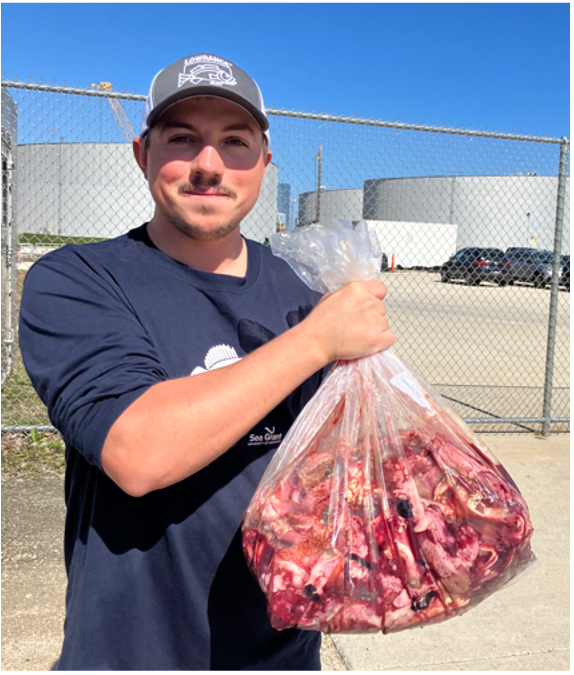By Kathleen Schmitt Kline
“Thirteen shanties are already in position and within a week as many more will be added.”
This was the news from 1889 on Lake Winnebago. Even with the reports of thin ice, there will likely be many, many more this year.
As spearers begin preparing to hunker down in their shanties in a few days, I’ve been thinking back to the summer I spent holed up in the archives of the Wisconsin Historical Society.
Pure bliss.
I love history, and so does Ron Bruch, one of my coauthors. When the Wisconsin Historical Society Press, the oldest publisher in the state, agreed to publish People of the Sturgeon, I knew I wanted to dive into our state archives to find as many historical records about sturgeon as I could. Part of my research focused involved digging through all of the State of Wisconsin records related to fishing.
Ron had a rough timeline of the history of sturgeon management in Wisconsin, so I used that as a guide as I sifted through records going back to the 1850s when Wisconsin was a new state creating all sorts of new legislation.
What a mess.
I’m really glad I wasn’t the one trying to protect natural resources in those days. First of all, no one wanted to hear anything about licenses or limits. But by the 1870s, it was clear that resources were indeed dwindling. So the state formed a Fisheries Commission in 1874 to survey the status of fisheries throughout the state. One of its main jobs became raising fish in hatcheries and stocking them all over the state, but the Commission also tried to make recommendations for laws to help protect fish and their habitat. This was the start of state wildlife management in Wisconsin—what would eventually become the Department of Natural Resources.
The laws seemed to be all over the place, changing from year to year. One year spears were outlawed; another year ice shanties were prohibited. But I started to notice a pattern. Certain parts of the state seemed to keep getting exemptions—areas along the Mississippi River, Green Bay and Lake Winnebago. These were places where French explorers arrived in the 1600s and where early missionaries first observed how the Menominee Indians speared sturgeon through the ice. Europeans who settled in these areas saw how successful the Native Americans were at harvesting sturgeon in the winter and began using the method themselves.
I think that by the time the state began regulating fishing in the late 1800s, spearing sturgeon through the ice was such a part of the culture for people living around Lake Winnebago that they simply wouldn’t accept a law prohibiting it. This strong connection to sturgeon and the culture of spearing would show up again and again during my research at the Wisconsin Historical Society. For others who may be historians at heart, here are a few excerpts from the fish and game laws and local newspapers:
1857 “A novel method of catching ‘the finny denizens’ of the lakes has been invented by our fishermen, and a very plentiful supply of fresh fish is obtained thereby. Small houses, fixed on runners are so constructed as to admit a stove and one or two persons, with room enough for their operations, and these movable concerns are placed above holes cut in the ice, from which the fish are taken with the spear.”
Reedsburg Herald, January 8
1887 Spearing outlawed statewide, “except that a spear may be used in the waters of the Mississippi river and sloughs, and also a spear may be used in the waters of Lake Winnebago, Fox and Wolf rivers for sturgeon only.”
1889 Many people were headed on to Lake Winnebago “with spear in hand to fasten to a sturgeon or perchance a passing pickerel. Thirteen shanties are already in position and within a week as many more will be added. A visit to one of these extemporized habitations will disclose to you two or more men, a miniature stove, many pipes with tobacco to make pleasant the situation. The basement upon close examination is ice with an aperture of two and a half feet in circumference which affords an opportunity to peer into the depths. An artificial minnow made of wood is suspended from the digit of the fisherman above, who entices the fish. Its appearance is unceremoniously ended by the dexterous spear, which lands Mr. Fish within the portals of the shanty.” Oshkosh Daily Northwestern, January 26.
1897 Ice shanties are prohibited on inland waters except for Sturgeon Bay and lakes in Waukesha County.
1898 Ice shanties become legal on Lake Winnebago.
1900 “A great many sturgeon are being taken through the ice on Lake Winnebago these days. The favorite fishing grounds are off Riverside park, Neenah, and in the vicinity of Waverly and Brighton Beach.” The Daily Northwestern, Oshkosh, March 3.
1903 “The first sturgeon to be taken from Lake Winnebago this season was speared Tuesday by Joseph Reimer at Menasha. It was about five feet six inches long and weighed forty-six pounds. Mr. Reimer, with Richard Arft, located a hole in the ice about two and a half miles off Mathewson’s point, and in a short time secured their fish. Last year they caught one of which the head alone weighed fifty-two pounds and the body 161.” The Daily Northwestern, Oshkosh, December 17.
1903 The state enacts a closed season on sturgeon March 1 – May 25 to protect the fish during their spawning runs. However, Lake Winnebago, Lake Winneconne, Lake Butte des Morts and the Fox and Wolf Rivers are exempt.





